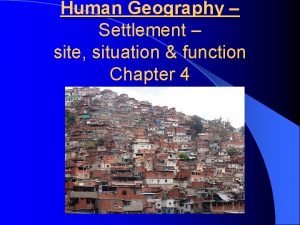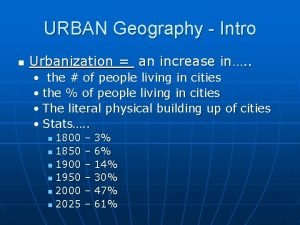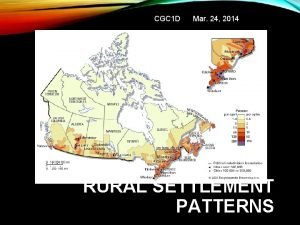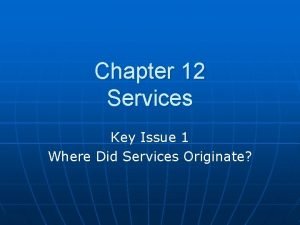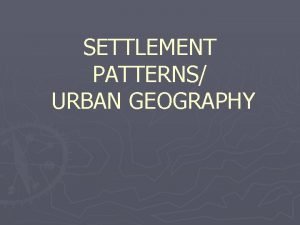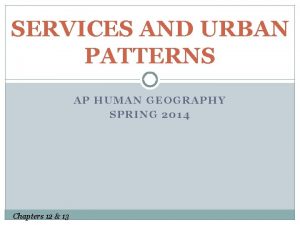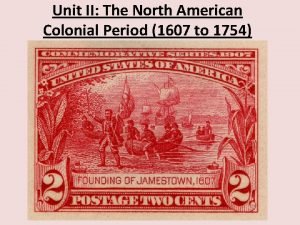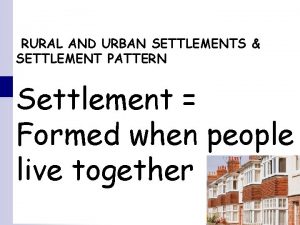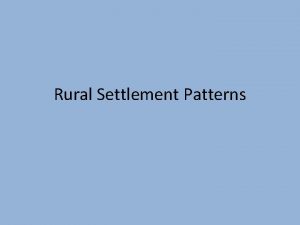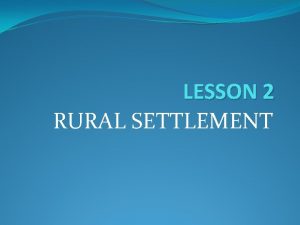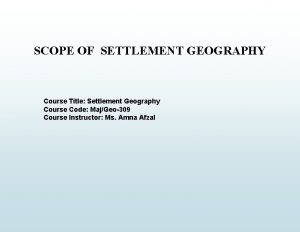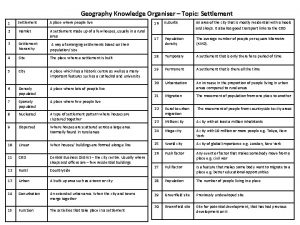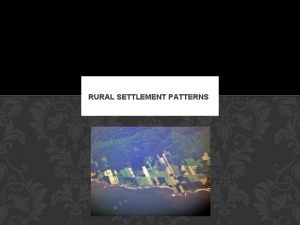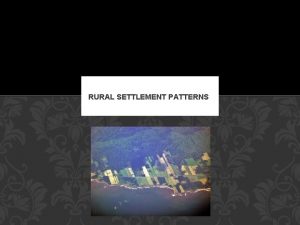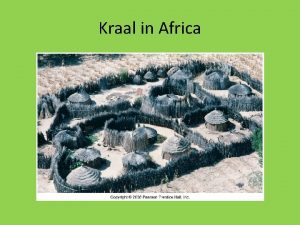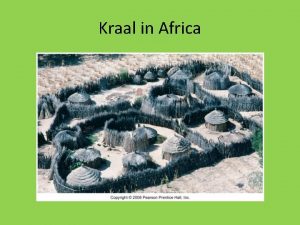GRADE 12 TOPIC SETTLEMENT GEOGRAPHY Rural Settlements Issues












- Slides: 12

GRADE 12 TOPIC: SETTLEMENT GEOGRAPHY Rural Settlements Issues 14 APRIL 2020

Important aspects for this lesson • Please revise all your concepts in your textbooks(mind the gap etc) • Rural-urban migration; Rural depopulation. • Causes and consequences of rural depopulation on people and the economy; • Case study that illustrates effects of rural depopulation and strategies to address them; and • Social justice issues in rural areas, such as access to resources and land reform.

Rural Depopulation- A decrease in the number of people living in rural areas. Rural Settlement Issues Rural Urban Migration The cycle of poverty illustrated below explains the situation which traps many rural populations with declining economic prospects. Rural- Urban migration – People move from the rural areas in search of better opportunitie s in cities

Rural Settlement Issues Push and pull factors causing rural-urban migration Push factors- forcing people to Reasons why moving might be move from the rural areas to the difficult urban areas (city) Pull factors – attracting people from rural areas to the cities § Unemployment § Mechanization on farms § Poor medical and family planning facilities § Fewer Primary and secondary schools § Limited Social opportunities § Poor services § Widespread poverty § Natural Hazards eg droughts. § Population pressure leading to insufficient land • Better career prospects • Better medical and family planning facilities • Better educational opportunities • Better housing • Better social life • Better shops, transport and communications • Higher wages and standard of living • Less threats from natural hazards § § § Costs Dangers Distance Transport Leaving family

RURAL-URBAN MIGRATION: Movement from rural to urban areas FACTORS PULL FACTORS PUSH FACTORS ATTRACT people to the cities FORCE people to the cities Better jobs Salaries Education Medical fac. Bright lights Mechanization Low salaries Droughts Crime Unemployment CONSEQUENCES TO CITY WHAT CAN BE DONE? • Advertise town • Recreation • Tourism • Restore buildings • Rural schools • Cheap Indus sites • Empty farmhouses • Crime (Farm murders) • Unemployment • Few new investments • Many old people • Few young men • Low value of properties • Shops close • Empty schools • Services below standard • Rural depopoulation

Social Justice Issues § Access to land § Poverty and the lack of access to resources hinder access to social justice. § Basic needs(Food, shelter, clothing and clean running water must be satisfied before any development can happen. § Improve services eg Electricity and roads WHAT IS SOCIAL JUSTICE? Ensuring that people are treated equally and that all their socials needs are provided for. AGENDA 21 – is a broad strategy to develop rural areas. Strategies to encourage people to stay in rural areas Land Reform In SA land is a highly contested resource. The current South African government aims to alleviate poverty especially in rural areas by transferring landownership to South Africans who have been denied access to this economic resource. This objective will be achieved through land reform programmes. What are these programs?

LAND REFORM

SOCIAL JUSTICE ISSUES IN RURAL AREAS CASE STUDY: TELLING THE STORY ABOUT SOUTH AFRICA'S RURAL POOR by Gara La. Marche This is a story about the Skhosanas, interviewed by Social Surveys Africa: Until 2001, they survived relatively well on the farm. They had a tap for water; they had firewood. Then the farm was sold to a new owner who wanted the Skhosanas off the land. For two years, they fought eviction. After all, this was the 'new' South Africa, and, for the first time, they had rights. But the farm owner shut down their water tap and ordered them to stop gathering wood on his land. Finally, the owner came early one morning when the children were still asleep, broke down the door, and threw the family's furniture and belongings onto the road. The children were afraid they would have nowhere to sleep. Mr Skhosana was ill and could not work anymore. Mrs Skhosana says she will never forget the experience of 'being thrown out like rubbish'.

Assessment – Social Justice Issues Read the article below on a social justice issue in South Africa 1. 1. 1 Explain what is meant by the term social justice. (1 x 1) (1) 1. 1. 2 Name the social justice issue that the story captures. (1 x 1) (1) 1. 1. 3 Why is the word 'new' emphasised in the article? (1 x 2) (2) 1. 1. 4 Name the law that secures the rights of people who live under insecure conditions on land owned by others. 1. 1. 5 Excluding the social justice issue mentioned in QUESTION 1. 1. 2 discuss TWO other social justice issues experienced in rural areas. 1. 1. 6 (1 x 2) (2 x 2) (4) Discuss any TWO problems that the government experiences with land reform. (2 x 2) (4) Total (13)

Memorandum to Assessment 1. 1. 1 Ensuring that people are treated fairly and that all their socials needs are provided for [CONCEPT] (1 x 1) (1) 1. 1. 2 Being denied access to a home. (1 x 1) (1) 1. 1. 3 It shows that although we are living in a democratic country some things have not changed (2) (1 x 2) (2) 1. 1. 4 Land tenure reform (2) (1 x 2) (2) 1. 1. 5 No access to piped water (2) No electricity (2) No access to basic services such as clinics, schools, proper infrastructure (2) Insufficient job opportunities, underpaid (2) [Any TWO. Accept other reasonable answers] (2 x 2) (4)

Memorandum to Assessment cont…. . 1. 1. 6 The willing buyer/seller principle takes time to settle (2) It takes time to mediate disputes and resolve issues (2) Huge costs are involved (2) Political interference (2) Distrust in government's reasoning (2) Eviction of farm workers despite the new land tenure laws (2) Lack of support from government (2) Disagreement between government and traditional leaders about the extent of land to be restored (2) People having no interest in farming or agricultural knowledge and therefore not utilising the redistributed land (2) [Any TWO. Accept other reasonable answers] 2 x 2) (4) Total (13)

Worksheets and answer sheets on the website • In conclusion I would like you to access the following on the department website : • Power. Point slides on Rural settlements, rural settlement issues. • Worksheets on Rural and Urban Settlements • Answer sheets to the worksheets. • KEEP SAFE AND SPEND AT LEAST ONE HOUR REVISING YOU WORK.
 Grade 12 geography settlement
Grade 12 geography settlement Site vs situation ap human geography
Site vs situation ap human geography Multiple nuclei model example
Multiple nuclei model example Rural settlement patterns
Rural settlement patterns Rural settlement patterns with diagrams
Rural settlement patterns with diagrams Dispersed rural settlement definition
Dispersed rural settlement definition Issues in canadian geography grade 9
Issues in canadian geography grade 9 Coolness index ap human geography
Coolness index ap human geography Geography and the settlement of greece
Geography and the settlement of greece Mega city definition ap human geography
Mega city definition ap human geography 300000/260
300000/260 French east india company
French east india company River rock funds
River rock funds

